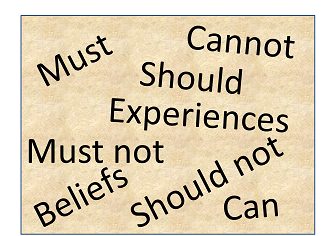- Official EFT Tutorial
- Before You Begin
- PART I For Everyone: The EFT Tapping Basics
- Using EFT Tapping For Yourself
- Using EFT Tapping Professionally
- What is EFT? - Theory, Science and Uses
- How to do the EFT Tapping Basics - The Basic Recipe
- The EFT Constricted Breathing Technique
- Are You Satisfied With 20% of EFT's Tapping Possibilities?
- Strategies for Getting Started: Pain, Personal Peace, Physical Disease and More
- The Pros and Perils of EFT Tapping Scripts
- What can I expect from EFT Tapping?
- PART II For Everyone: Getting to the Roots of Your EFT Issues
- Intro to Part II
- Finding Aspects within the EFT Tapping Process
- Intro to Being Specific With EFT Tapping
- Testing Your EFT Tapping Work - The Triad
- Uncovering Specific Events - An Essential Concept Within the EFT Tapping Process
- The EFT Tell the Story Technique - The Workhorse Tapping Method
- What Should I Say During the EFT Tapping Process?
- The EFT Generalization Effect - A Big Step Toward Tapping Efficiency
- The EFT Personal Peace Procedure
- When to Use Global Approaches in the EFT Tapping Process
- The EFT Tapping Success Strategy
- PART III - Advanced: Additional Tapping Tools & Refinements
- Intro to Part III
- The EFT Movie Technique - A Useful Tapping Tool
- The EFT Tearless Trauma Technique
- Chasing the Pain - Deeper EFT Relief
- Cognitive Shifts - Belief Changes Within EFT
- Common EFT Challenges
- Emphasizing the Words - More Tapping Power When Needed
- Advanced Testing Techniques
- Testing The Tabletop
- Before You Move On To Deeper EFT Tapping Work...
- PART IV - Advanced: Tapping Deeper Into Emotional Issues
- PART V - Advanced: Polishing the Process & Expanding the Language
- EFT Bonus Articles
Table of Contents Help
The tabs on the right are shortcuts to where you have been:
- Previous Screen
- Previous Articles
- Previous Categories
- Start Page
- Hide Entire Menu
Swiping to the left will take you to the previous screen.
The folder icon indicates that more content is available. Click on the icon or the associated text, or swipe to the right to see the additional content.
Official EFT Tutorial
PART IV - Advanced: Tapping Deeper Into Emotional Issues
The Writing on Our Walls - An Important EFT Concept
An Ideal EFT Tapping Metaphor For Why We Behave As We Do

I have been a student of personal improvement and human behavior since I was a teenager. That journey has exposed me to a wide variety of theories about why people have the challenges they face and what it might take to overcome them. I have personal experience with all of the theories, and have experimented with my own version of those theories for decades.
Eventually I came up with a metaphor that makes perfect sense to me and I call it the Writing on our Walls. To me, it explains perfectly how the events in our lives create our beliefs about the world, and how those beliefs can either pose limits or open new possibilities.
As I was developing EFT, this metaphor was already second nature to me. When I work with clients, my understanding of their issues is based on the Writing on their Walls. Every question I ask, every direction I choose to go, every test I perform, and every bit of language I use comes from that perspective, so understanding it will help you get a lot more out of EFT.
The rest of this article has been compiled from my previous writings on the Writing on our Walls concept and includes video discussions for illustration.
~~~~~~~~~~~~~~~

The Palace of Possibilities
We live in a Palace of Possibilities. It is an ever expanding structure, filled with awesome rooms and annexes that are loaded with achievements and joy. These rooms are open to everyone, although most of us only visit a few of them. It's not that we are barred from any of the rooms. Rather, it's that we choose to dwell only in those rooms within which we are comfortable.
Somehow, we don't "belong" in those other, more expansive rooms. They are for others. They are for richer people and more privileged people and people with more talent than us. We stay within the familiar (our comfort zones) and don't venture beyond the walls (limits) of the rooms we have chosen. Why? Because our cans and can'ts are written on those walls and we obey those dictates as though they were real. They are reflected in our careers, our incomes, our relationships, and even our self image. In fact, there is scarcely any part of our makeup that is not affected by what's written on those walls.
The words on our walls are metaphors for our self talk, of course. They represent the attitudes, opinions & beliefs that we have accumulated over the years. Many of them are hand-me-downs from our parents, grandparents, teachers, coaches, religion, peers, books, TV and an endless list of other "authorities" in our lives. Upon inspection many of them are laughable. Nonetheless, they still seem to have a hold on our progress.
We all have different words on our walls. That's why we appear to have different limits. Your limits are different from mine because the "truths" written on your walls are different from the "truths" written on mine. However, they are not really "truths" at all. They are just the guidelines we have adopted for getting through life … AND … many of them are fictions. They are hand-me-down beliefs that were written on our walls by others and we have been dutifully obeying them ever since. This need not be.
Below is a video wherein I discuss this important point with a live audience.
THE WRITING ON OUR WALLS: INTRO - WATCH VIDEO
This brings me to a foundational concept. Its truth is undeniable, yet it is so subtle that we tend to ignore it. Here it is:
We constantly consult the writing on our walls.
That writing is our most prominent advisor and we consult it all day long. And why not? It represents every experience we have ever had. It contains all of our "how to's." It contains our cans & can'ts as well as our shoulds & should nots. It contains our musts & must nots as well as our sense of fair play. It contains our version of proper behavior as well as what is right or wrong in this world. It contains our judgments, our successes and our failures. It's all there … everything we hold to be true … written on our walls.
For example, we eat soup with a spoon instead of a fork because our knowledge base (the writing on our walls) advises us to do so. This is subtle, I know, but it's as if we ask the question, "How do I eat this soup?" and the writing on our walls says, "Use a spoon." This is why we wear jeans on some occasions and black tie or evening gowns on others. We constantly consult the writing on our walls for what to do. Those words represent the "truth" as we have learned it.
We consult those walls for just about everything. Those words tell us about our opportunities as well as our limits … and often they conflict with each other. On the subject of finances, for example, they may tell us, "This is America, the land of opportunity--go for it." But they may also tell us....
"You are too young (or too old) for that."
"You don't have enough education."
"You are a woman and are limited by the glass ceiling."
"You are a minority."
"People who take risks end up broke."
"Getting ahead depends on who you know."
"Rich people are dishonest."
This fictional list of limits goes on indefinitely, of course. Are any of them written on your walls? If you believe any of them … or if any of them ring true ... I suggest that you have bought into an expensive "limit" that need not be there.
Below is a video wherein I explore with a live audience this vital concept.
WE CONSTANTLY CONSULT THE WRITING ON OUR WALLS - WATCH VIDEO
Now consider this…
My consistent thoughts become my reality.
Although we don't often hear it stated this way, the main goal of psychotherapy has always been to have clients change their consistent thoughts so that the quality of their lives (their reality) will shift for the better. The primary goal has been to get clients to think differently about their traumas, fears, guilt, grief, etc. in hopes that they will put these things "in perspective" and go about their lives more positively. Their consistent thoughts, once changed, become their new reality.
Many clients are unaware of The Palace of Possibilities in which they live because they dwell in their own personal dungeons amidst their thoughts of past abuses, war memories, fear, guilt and the like. Their consistent thoughts have become their reality and, when they walk into your therapy office, they bring their dungeons with them. The writing on their walls provides graphic evidence of their personal guilt, shame, etc. and IT IS WRITTEN THERE IN CAPITAL LETTERS, SHOUTING AT THEM. There is other writing, of course … even some writing of a more positive nature. However, it is overwhelmed by those capital letters. Those capital letters become the focus of their thinking … the centerpiece of their existence. They have become lifetime "limits" and will continue to do so until that writing is erased and replaced.
This reminds me of "Ned," a neighbor of mine. Ned is the ultimate pessimist and is quite proud of it. His conversation consistently turns to the problems in his life, the world, etc. and, as you might expect, he has managed to manifest many problems in his reality. By contrast, I am quite optimistic. In the eyes of some (especially Ned), I would give major competition to Pollyanna. I am forever looking for opportunity and, interestingly enough, I seem to find it. Ned also seems to find what he is looking for (problems). He rarely finds opportunity. We see the world quite differently, yet we are both looking at the same world.

Many years ago, Ned and I were in conversation about the movie "Rocky." I thought the movie was exhilarating. To me, it was all about how a "has-been" could pull himself up by his bootstraps and fight the heavyweight champion of the world. It was exciting. It was a glorious example of the power of the human spirit. However, when I asked Ned about his opinion of the movie he said, "It was about two bums beating each other up."
Even though the movie was identical for both of us … exactly the same words, pictures, music, etc. … we had diametrically opposite reactions. How could this be? The only difference, of course, was what we brought to the movie. It was our filter (our consistent thoughts) through which we perceived the events and gave them meaning (our reality). That movie, like life, was the outer projection of an inner state. Our experience of it was strictly an "inside job." We see life as a projection/reflection of our mindset. Our consistent thoughts become our reality.
Again, we are constantly consulting the writing on our walls. We do it all day long and the most prominently written words on our walls become our consistent thoughts (and thus our reality). We would, of course, all like to have a better reality. We would prefer to have more emotional freedom … to be more spiritually evolved … to live in the more expansive annexes of our personal Palace of Possibilities. It follows then, that the way to achieve a better reality is to change our consistent thoughts because changing our consistent thoughts automatically changes our reality.
Below is video emphasizing this point.
THE WRITING ON OUR WALLS: "MY CONSISTENT THOUGHTS BECOME MY REALITY." - WATCH VIDEO
I am aware that this is a cognitive sort of approach and, as such, some of it is old (but powerful) stuff. What takes us to new levels here is the combination of these tools with EFT. Releasing the heavy emotional stuff is like erasing the writing on the walls. Once we erase the limiting words from our walls, we are free to replace them with whatever we want … and the result is freedom from those limits.
What happens when you try to add new information to your Walls?
An empty coke bottle was the star of a movie many years ago.

If you saw “The Gods Must Be Crazy” then you already know the many lessons it has for us. In that movie an empty coke bottle was thrown out of a small airplane while flying over a sparsely populated, "uncivilized" tribal land. The natives found it and, having no writing on their walls about coke bottles, were quite puzzled about it. They didn't know what to make of this strangely shaped thing with white markings on it. Where did it come from? Did it grow on a tree? How could something so hard be so transparent?
To give this coke bottle meaning, the natives had to "fill in the blanks" as best they could from the writing on their walls. The natives thus assigned all kinds of meanings for this "gift," including the assumption that it must be an omen from the Gods. It became a prized possession and various factions of the tribal community had fights over it. It caused so much stress and consternation that the natives finally concluded that the Gods must be crazy. So they threw it off of the edge of the world (a high cliff) in an effort to give it back to the Gods.
There is an old saying that goes, "Nothing has any meaning except the meaning we give it." I have found it quite useful over the years but wish to restate it now to fit within the Palace of Possibilities metaphor. Restated, it goes like this,
"Nothing has any meaning except that
which is written on our walls."
Indeed, our personal meaning for everything from a coke bottle to the Bible is written on our walls. This meaning includes, of course, the many shadings that reflect our personal experiences. Hand me a baseball, for example, and I will hold it fondly and recreate within myself the many great baseball memories that shaped my early years. Hand a baseball to someone else, however, and it will simply be an inanimate object that other people use to play a silly game. They may even greet it with disdain if it represents the rejection of not being chosen for the team. A baseball is a baseball. But the meaning we give to it can be widely different. It's all written on our walls.
It should be clear by now that we constantly consult the writing on our walls in order to derive meaning from the barrage of sensory data we receive all day long. Even as you read these words your system is asking, "what do these words mean" and, of course, you get a reflection from the writing on your walls that serves as your answer. Your system compares the words you are reading with your existing database of experiences, beliefs, etc. (writing on your walls) and interprets the words for you. This is subtle, of course. Very routine. We rarely give the process any more than a passing thought. But, like breathing, we do it all day long.
But what do we do when we come across something for which there is no writing on our walls? How do we make sense of it when our walls are blank on the subject? Simple. We do what the natives did with the coke bottle. We make up a meaning that fits as closely as possible within the "truth" that is already written on our walls. The resulting "meaning" is probably fictitious, of course, but that doesn't keep us from doing it. It is a human need to make meaning of the world around us and we will always (yes, I said always) do it in a manner that fits within our existing beliefs.
Observe children in this regard. They often come across new things (at least new to them) and they make up meanings for them by "filling in the blanks" from the limited writing on their walls. Thus an earthquake is a monster stomping its feet and Preparation H is what Grandpa uses for toothpaste. When children do this, we call it fantasy. But when we do it, we call it reality.
As adults, we don't often come across totally new items in our environment but we do experience partial information with great frequency. To give full meaning to this partial information we (like the children) fill in the blanks from the writing on our walls. The Vietnam Veteran who hears the word "war" fills in the blanks with a far different meaning than does the teenage videogame player. The victim of an abusive father fills in the blanks regarding Father's Day much differently than do others.

Therapy clients are constantly filling
in the blanks to make meaning
of the world around them.
This is critically important to recognize because it is at the very center of emotional healing. Therapy clients are constantly filling in the blanks to make meaning of the world around them.
Listening to clients as they fill in the blanks leads to big clues regarding core issues. True healing on these issues is evidenced by how they fill in the blanks before and after using EFT. This is important. Very important. In some cases, listening to the changes in how clients fill in the blanks can be more useful than the 0-10 scale because it often points to more healing. The 0-10 scale is quite useful, of course, but nothing is as useful as the cognition change that is evidenced by how the client fills in the blanks. That cognition change is the true bottom line.
Finally, there is a freedom involved in fully recognizing what we do with the writing on our walls. Recognizing that everyone (including ourselves) constantly consults that writing for their version of the "truth," leads to more peaceful understandings and forgiving attitudes. It helps us to stand back from disagreements and de-personalize other people's actions. After all, they're just spouting off what other people have written on their walls as though it was somehow the "truth." It allows us to smile at our own comedies and recognize our personal "limits" as being mental fictions that are little more than hand-me-down beliefs from previous generations of parents, teachers, peers, and others that we relied on for guidance in this world.
What happens when the Writing on your Walls is challenged?
(The Tail-Ender)
We have already discussed the general process of adding new information to your Walls. If there isn’t any reference to go with, you simply create, using what is already written on your walls, a meaning that fits. But what happens when the new information is in direct opposition to what‘s already there? Here, we introduce the “Tail Ender”. It’s the self talk that provides an instantaneous objection to new information that might conflict with your existing “truth” about the world.
- If I tell people that the color of the sky is brown, their likely self talk might be something like, “That’s ridiculous. The sky is blue”.
- If I try to convince my neighbor, Ned, that Rocky is an inspirational movie. His self talk would likely say, “No one wants to be a bum like those guys.”
- If I tell a poor man that he could be a millionaire. His self talk might say, “Yeah, but then I’d be greedy.”
The Writing on your Walls is there to help you navigate through a world that is often uncertain. It helps you make “intelligent” choices, it helps you avoid danger, and it reinforces your view of what is valuable in this world … it is there to keep you safe. We rely on those “truths” much more strongly than we realize, and that becomes most evident when they are directly challenged.
A first class way to challenge the Writing on someone’s Walls is to use a technique called Affirmations. This technique has been around for decades as a personal improvement tool based on the popular premises of “positive thinking,” “mind over matter,” or “you are what you think.” In general, you decide on a goal like losing weight, making more money, or whatever else you can dream up, and design a statement that assumes your goal has become a reality.
- My normal weight is 130 pounds.
- I earn $100,000 per year easily and consistently.
- I am now irresistible to my perfect romantic partner.
Properly designed, an Affirmation will be in direct conflict with the Writing on your Walls. It affirms a reality that not only isn’t currently true, but stretches your belief about what is possible. More importantly, it also produces Tail Enders which bring with them valuable information about the emotional makeup of any client.
Here's an example of what I mean. Let's say a 200 pound woman uses an affirmation aimed at weighing 130 pounds. She might affirm something like this...
"My normal weight is 130 pounds and that's what I weigh."
As a result, she is likely to have one or more "tail enders" show up at the end of her affirmation. They might go like this...
- "But if I lose the weight, others will expect me to keep it off."
- "But if I lose the weight, I will have to spend a lot of money for new clothes."
- "But if I lose the weight, men will hit on me and expect sex."
- "But if I lose the weight, men may not hit on me and then I will know I’m not loveable.
- "But if I lose the weight, I will have to give up my favorite foods."
This list of possible tail enders is endless. These are just examples. They are not spoken or articulated, of course, but are subtle (and powerful) reflections of the existing obstacles for losing weight. They are the "yes, buts" and, in fact, represent the true affirmation. That is why affirmations don't work well in practice, despite the persuasive logic behind them. They are typically followed by the opposing tail-ender which always has the last word on the subject. Thus it wins the argument and keeps people right where they were before the affirmations came out their mouths. If you are an EFT Practitioner treating someone who wants to lose weight, knowing these dynamics can save you a lot of time.
More importantly for the EFT process, Tail Enders often point directly to the Specific Events that contributed to those beliefs. To carry on with our weight examples, consider these explorations with clients:
- “If others expect you to keep the weight off, how do you know that? Did someone say that to you?” Maybe someone’s parents made it clear over and over that once you achieve something you must never let it go, or maybe there were peers in school who judged someone who had lost weight then put it back on.
- “If men will hit on you and expect sex, what is wrong with that? Was there a time when having sex was uncomfortable for you? Have you ever felt pressure to have sex?” Maybe there were uncomfortable dating experiences or unreasonable pressures to have sex. Finding those Specific Events will go a long way toward getting deeper results with EFT.
- “If losing weight means you will have to give up your favorite foods, was there ever a time when you were deprived of food? Or when snacks were taken away as a punishment?” As soon as you find a Specific Event, head straight for the Tell the Story Technique to release that disruption.
In most cases when someone reveals their objection to reaching a goal, it represents a fear or a memory of discomfort. Those Specific Events can usually be revealed by asking “what does that remind you of?” or some variation thereof.
Using this metaphor of the Writing on our Walls, the existing Writing would represent our existing “affirmations” about what is true in our world. The conventional affirmation process attempts to replace those truths with new truths. However the tail enders provide strong competition. They act as persistent reminders that we want our truths, we are comfortable with our truths, and we won’t be giving them up easily. Those “affirmations,” positive or negative, will dictate our choices as long as they are in place.
If we listen to ourselves talk, we will hear our "limits" and other forms of affirmations come rolling out of our faces. Things like...
- "I can't sing,"
- "Making money isn't spiritual,"
- "Women can't compete in a man's world,"
- "I never seem to find the right words,"
- etc. etc. etc.
...are regarded as “truths” that keep us right where we are. We are using them every minute of the day. They shape our lives because they reflect our beliefs and our attitudes. You are using them right now as you read this. You are consulting the writing on your walls (your existing affirmations) to agree or disagree with what I am saying. Have you found yourself saying, "Yes, but..." while reading any part of this Tutorial? If so, you are affirming something, perhaps a limit.
We already know that EFT serves as a highly effective eraser for all the negative emotions and beliefs that we have written on our Walls. Once we can navigate through someone’s belief system, we can uncover the important core issues and related Specific Events that need to be addressed in order to release EFT’s full potential.
© Gary and Tina Craig
All Rights Reserved
Please note: This Tutorial, while useful, was replaced in 2014 by my newest advancement, Optimal EFT. More efficient. More powerful. Full explanation given in my free, easy-to-read e-book, The Unseen Therapist.






